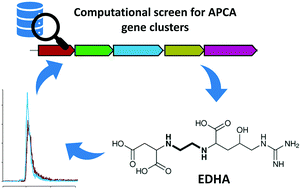Identification of a novel aminopolycarboxylic acid siderophore gene cluster encoding the biosynthesis of ethylenediaminesuccinic acid hydroxyarginine (EDHA)†
Abstract
The mechanism of siderophore-mediated iron supply enhances fitness and survivability of microorganisms under iron limited growth conditions. One class of naturally occurring ionophores is the small aminopolycarboxylic acids (APCAs). Although they are structurally related to the most famous anthropogenic chelating agent, ethylenediaminetetraacetate (EDTA), they have been largely neglected by the scientific community. Here, we demonstrate the detection of APCA gene clusters by a computational screening of a nucleotide database. This genome mining approach enabled the discovery of a yet unknown APCA gene cluster in well-described actinobacterial strains, either known for their potential to produce valuable secondary metabolites (Streptomyces avermitilis) or for their pathogenic lifestyle (Streptomyces scabies, Corynebacterium pseudotuberculosis, Corynebacterium ulcerans and Nocardia brasiliensis). The herein identified gene cluster was shown to encode the biosynthesis of APCA, ethylenediaminesuccinic acid hydroxyarginine (EDHA). Detailed and comparatively performed production and transcriptional profiling of EDHA and its biosynthesis genes showed strict iron-responsive biosynthesis.



 Please wait while we load your content...
Please wait while we load your content...